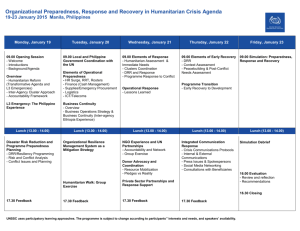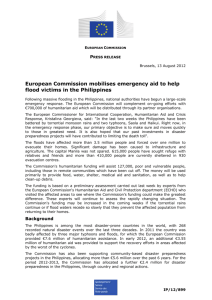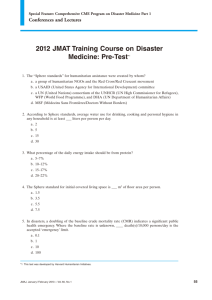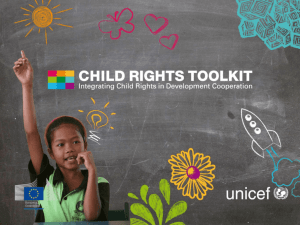Anticipatory Humanitarian Action: Forecast-based early warning protocol
advertisement
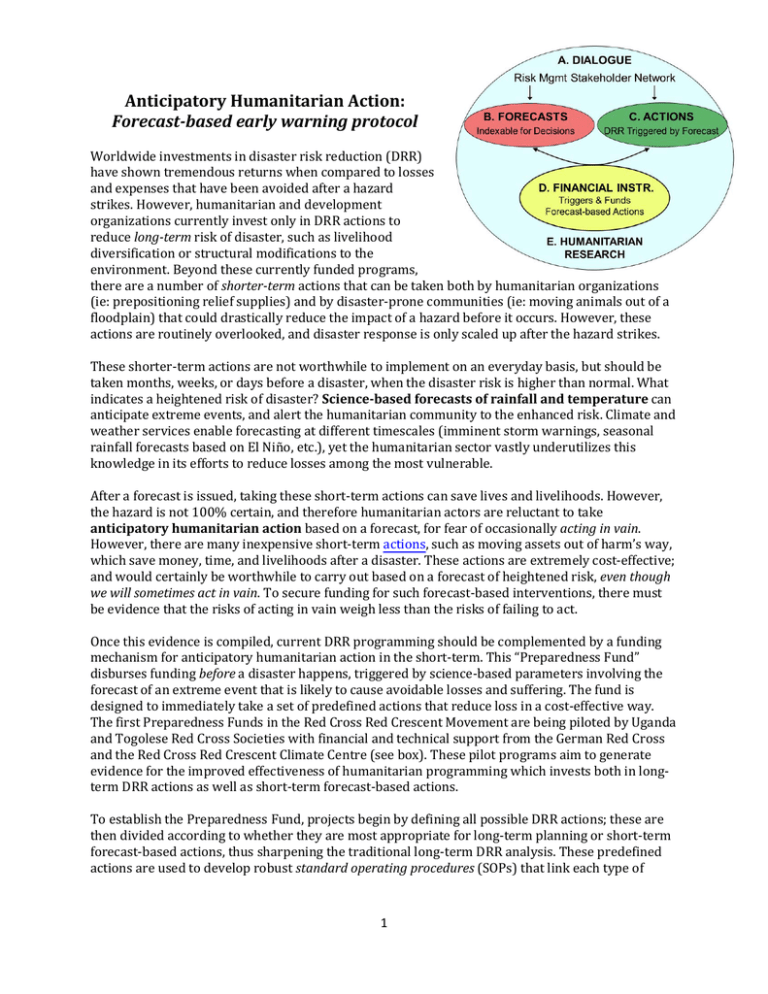
Anticipatory Humanitarian Action: Forecast-based early warning protocol Worldwide investments in disaster risk reduction (DRR) have shown tremendous returns when compared to losses and expenses that have been avoided after a hazard strikes. However, humanitarian and development organizations currently invest only in DRR actions to reduce long-term risk of disaster, such as livelihood diversification or structural modifications to the environment. Beyond these currently funded programs, there are a number of shorter-term actions that can be taken both by humanitarian organizations (ie: prepositioning relief supplies) and by disaster-prone communities (ie: moving animals out of a floodplain) that could drastically reduce the impact of a hazard before it occurs. However, these actions are routinely overlooked, and disaster response is only scaled up after the hazard strikes. These shorter-term actions are not worthwhile to implement on an everyday basis, but should be taken months, weeks, or days before a disaster, when the disaster risk is higher than normal. What indicates a heightened risk of disaster? Science-based forecasts of rainfall and temperature can anticipate extreme events, and alert the humanitarian community to the enhanced risk. Climate and weather services enable forecasting at different timescales (imminent storm warnings, seasonal rainfall forecasts based on El Niño, etc.), yet the humanitarian sector vastly underutilizes this knowledge in its efforts to reduce losses among the most vulnerable. After a forecast is issued, taking these short-term actions can save lives and livelihoods. However, the hazard is not 100% certain, and therefore humanitarian actors are reluctant to take anticipatory humanitarian action based on a forecast, for fear of occasionally acting in vain. However, there are many inexpensive short-term actions, such as moving assets out of harm’s way, which save money, time, and livelihoods after a disaster. These actions are extremely cost-effective; and would certainly be worthwhile to carry out based on a forecast of heightened risk, even though we will sometimes act in vain. To secure funding for such forecast-based interventions, there must be evidence that the risks of acting in vain weigh less than the risks of failing to act. Once this evidence is compiled, current DRR programming should be complemented by a funding mechanism for anticipatory humanitarian action in the short-term. This “Preparedness Fund” disburses funding before a disaster happens, triggered by science-based parameters involving the forecast of an extreme event that is likely to cause avoidable losses and suffering. The fund is designed to immediately take a set of predefined actions that reduce loss in a cost-effective way. The first Preparedness Funds in the Red Cross Red Crescent Movement are being piloted by Uganda and Togolese Red Cross Societies with financial and technical support from the German Red Cross and the Red Cross Red Crescent Climate Centre (see box). These pilot programs aim to generate evidence for the improved effectiveness of humanitarian programming which invests both in longterm DRR actions as well as short-term forecast-based actions. To establish the Preparedness Fund, projects begin by defining all possible DRR actions; these are then divided according to whether they are most appropriate for long-term planning or short-term forecast-based actions, thus sharpening the traditional long-term DRR analysis. These predefined actions are used to develop robust standard operating procedures (SOPs) that link each type of 1 forecast with suitable action. Forecasts with more certainty (ie: imminent flood warning) can be linked to more difficult or expensive actions than more general seasonal forecasts. Preparedness Fund in Uganda and Togo Many actions, such as handThis Integrated Climate Change Adaptation Project is funded by Germany’s washing campaigns before a Federal Ministry for Economic Cooperation and Development through the potential flood, will have longGerman Red Cross, and is being implemented by the Uganda and Togolese term lasting effects that are Red Cross Societies with technical support from the Red Cross Red Crescent beneficial to the community Climate Centre. The project runs for six years, and invests 2.2 million Euro even if the disaster does not in Uganda and 1.8 million in Togo. Uganda Togo materialize. However, all Main Hazards Waterlogging, flash floods, Riverine floods actions have an opportunity drought cost, and therefore the SOP Long-term DRR Diversified agricultural Flood-proof houses, internalizes this risk and investment production, access to water, health and hygiene authorizes early action based natural resource education, natural on pre-calculated management resource management probabilities. Because this is Preparedness 100,000 Euro 50,000 Euro standard protocol, individuals Fund are not blamed for the Anticipatory Using forecasts of rainfall in Based on forecasts of instances of acting in vain, and Humanitarian the highlands, anticipatory river levels rising, action the protocol is designed such Action action will prevent will focus on movement of that the benefit of funding disasters of waterlogging goods and people before a and water-borne diseases flood, as well as hygiene early action every time the in the lowlands promotion trigger is reached will outweigh the cost of sometimes acting in vain. The final result will be an institutionalized mechanism that can greatly improve the efficiency and effectiveness of work in the humanitarian sector. This type of preparedness fund is not only relevant in today’s world, but becomes increasingly important in a changing climate. Red Cross National Societies have an active presence in vulnerable communities across the world, with an explicit mandate to integrate adaptation to a changing and more uncertain climate into plans and policies, but often lack both technical capacity to utilise climate services and financial means to build and integrate adaptation capacity into a robust disaster risk management system. The annual number of climate-related disasters has more than doubled since 1980 and their damages have almost tripled. With climate change, the number of extreme weather events are projected to increase. Given this growing demand under human and financial resource constraints, the humanitarian sector cannot successfully manage rising climate risks using “business as usual” approaches. A climate-smart, more cost-effective risk reduction approach is needed to link science-based forecasts with adaptive early action to enhance resilience in the most vulnerable communities. Forecast: Likely that the next 3 MONTHS will be unusually wet Obtain emergency food and water supplies Eliminate malaria breeding sites Recruit and train volunteers Forecast: Heavy rainfall possible in the next WEEK Train volunteers on flood protocol Transport emergency kits to rural locations Train communities on hygiene for water-borne disease Forecast: Rain likely in next few HOURS; high water upstream Develop beneficiary targeting and registration system Provide basic medical supplies to clinics Move supplies to most at-risk locations Examples of flood response actions that are currently funded post-disaster by the IFRC Disaster Relief Emergency Fund in that could be triggered by forecasts before floods materialize, reducing human suffering and improving the effectiveness of humanitarian investment. Examples taken from Kenya and the Philippines. 2 MIT OpenCourseWare http://ocw.mit.edu CMS.611J / 6.073 Creating Video Games Fall 2014 For information about citing these materials or our Terms of Use, visit: http://ocw.mit.edu/terms.

